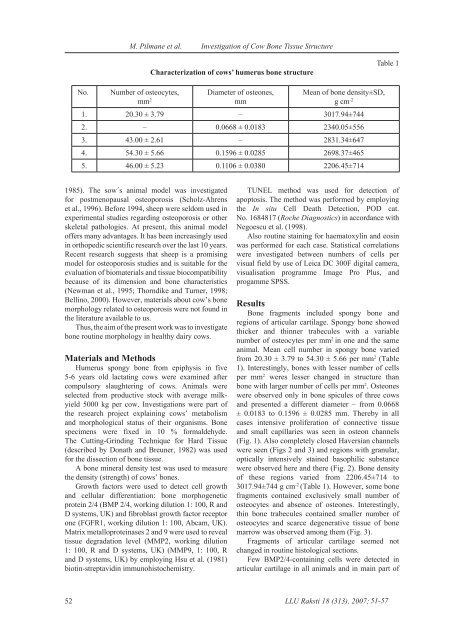Latvijas LauksaimniecÄ«bas universitÄtes raksti nr. 18 (313) , 2007 ...
Latvijas LauksaimniecÄ«bas universitÄtes raksti nr. 18 (313) , 2007 ...
Latvijas LauksaimniecÄ«bas universitÄtes raksti nr. 18 (313) , 2007 ...
You also want an ePaper? Increase the reach of your titles
YUMPU automatically turns print PDFs into web optimized ePapers that Google loves.
M. Pilmane et al. Investigation of Cow Bone Tissue StructureCharacterization of cows’ humerus bone structureTable 1No.Number of osteocytes,mm 2Diameter of osteones,mmMean of bone density±SD,g cm -21. 20.30 ± 3.79 – 3017.94±7442. – 0.0668 ± 0.0<strong>18</strong>3 2340.05±5563. 43.00 ± 2.61 – 2831.34±6474. 54.30 ± 5.66 0.1596 ± 0.0285 2698.37±4655. 46.00 ± 5.23 0.1106 ± 0.0380 2206.45±7141985). The sow´s animal model was investigatedfor postmenopausal osteoporosis (Scholz-Ahrenset al., 1996). Before 1994, sheep were seldom used inexperimental studies regarding osteoporosis or otherskeletal pathologies. At present, this animal modeloffers many advantages. It has been increasingly usedin orthopedic scientific research over the last 10 years.Recent research suggests that sheep is a promisingmodel for osteoporosis studies and is suitable for theevaluation of biomaterials and tissue biocompatibilitybecause of its dimension and bone characteristics(Newman et al., 1995; Thorndike and Turner, 1998;Bellino, 2000). However, materials about cow’s bonemorphology related to osteoporosis were not found inthe literature available to us.Thus, the aim of the present work was to investigatebone routine morphology in healthy dairy cows.Materials and MethodsHumerus spongy bone from epiphysis in five5-6 years old lactating cows were examined aftercompulsory slaughtering of cows. Animals wereselected from productive stock with average milkyield5000 kg per cow. Investigations were part ofthe research project explaining cows’ metabolismand morphological status of their organisms. Bonespecimens were fixed in 10 % formaldehyde.The Cutting-Grinding Technique for Hard Tissue(described by Donath and Breuner, 1982) was usedfor the dissection of bone tissue.A bone mineral density test was used to measurethe density (strength) of cows’ bones.Growth factors were used to detect cell growthand cellular differentiation: bone morphogeneticprotein 2/4 (BMP 2/4, working dilution 1: 100, R andD systems, UK) and fibroblast growth factor receptorone (FGFR1, working dilution 1: 100, Abcam, UK).Matrix metalloproteinases 2 and 9 were used to revealtissue degradation level (MMP2, working dilution1: 100, R and D systems, UK) (MMP9, 1: 100, Rand D systems, UK) by employing Hsu et al. (1981)biotin-streptavidin immunohistochemistry.TUNEL method was used for detection ofapoptosis. The method was performed by employingthe In situ Cell Death Detection, POD cat.No. 1684817 (Roche Diagnostics) in accordance withNegoescu et al. (1998).Also routine staining for haematoxylin and eosinwas performed for each case. Statistical correlationswere investigated between numbers of cells pervisual field by use of Leica DC 300F digital camera,visualisation programme Image Pro Plus, andprogamme SPSS.ResultsBone fragments included spongy bone andregions of articular cartilage. Spongy bone showedthicker and thinner trabecules with a variablenumber of osteocytes per mm 2 in one and the sameanimal. Mean cell number in spongy bone variedfrom 20.30 ± 3.79 to 54.30 ± 5.66 per mm 2 (Table1). Interestingly, bones with lesser number of cellsper mm 2 weres lesser changed in structure thanbone with larger number of cells per mm 2 . Osteoneswere observed only in bone spicules of three cowsand presented a different diameter – from 0.0668± 0.0<strong>18</strong>3 to 0.1596 ± 0.0285 mm. Thereby in allcases intensive proliferation of connective tissueand small capillaries was seen in osteon channels(Fig. 1). Also completely closed Haversian channelswere seen (Figs 2 and 3) and regions with granular,optically intensively stained basophilic substancewere observed here and there (Fig. 2). Bone densityof these regions varied from 2206.45±714 to3017.94±744 g cm -2 (Table 1). However, some bonefragments contained exclusively small number ofosteocytes and absence of osteones. Interestingly,thin bone trabecules contained smaller number ofosteocytes and scarce degenerative tissue of bonemarrow was observed among them (Fig. 3).Fragments of articular cartilage seemed notchanged in routine histological sections.Few BMP2/4-containing cells were detected inarticular cartilage in all animals and in main part of52LLU Raksti <strong>18</strong> (<strong>313</strong>), <strong>2007</strong>; 51-57
















